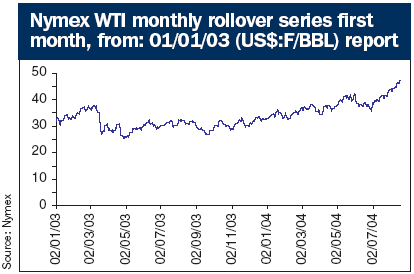
Corporates wise up to oil hedges
Apervading sense of uncertainty in the oil market is encouraging more corporates to prioritise risk management issues, according to Orrin Middleton, an energy marketer at Barclays Capital in London.
He says some companies with no previous experience of using derivatives are now coming to the market to see how they can reduce costs.
“Some corporates had got used to an oil price range of $20–30, and energy price risk management was way down their list of priorities. Now that the Brent crude price is over $40 per barrel and heading towards $50, with most analysts pointing to higher numbers and increased volatility over the next few years, corporates are more inclined to start writing energy hedging policies.”
Options have been one of the most popular products to hedge against rising prices, says Xavier Trabia, executive director in the marketing and structuring group at Morgan Stanley in London. “Options are attractive because companies don’t want to be exposed if the market goes down quickly in the next few weeks. So they’re ready to pay some big premiums,” he says.
Middleton agrees. “In a high oil-price environment, more corporates are looking for hedging strategies that allow them to benefit should prices drop again.”
Where put options were relatively expensive last year, the perception of a likely continuation of rising oil prices has made them relatively cheap, while call options have gained popularity as an effective hedge, says Wayne Harburn, head of commodities trading at ABN Amro.
Serge Topolanski, an energy trader at Société Générale in Paris, says puts have maintained a similar to slightly lower premium between last December and now, whereas a call for $5 above the market price (strikethrough, with the same delta) has gone from being approximately a one and a half volatility point discount to at-the-money to being a two volatility points premium.
Plain vanilla instruments such as call spreads have proven popular with the market in the past three months, where a client can buy a call at $47 and sell a call at $52, giving a hedge on the spread, according to Trabia. This reduces the premium of the overall hedging structure.
Another option would be a simple swap with a cap, where protection is sold at a discount, but only up to a certain price. Clients are mostly still unwilling to tie themselves in to long-term hedges on the chance that prices suddenly start to fall and they are caught out buying hedges at the top of the market, Trabia adds.
Middleton says corporates are generally attracted to vanilla products, for the ease of reporting both to the board and for IAS 39 requirements. Exotic structures, such as knock-outs, where protection is offered cheaper but becomes void if prices breach a certain level, can be very useful in specific circumstances for certain kinds of consumers, he says. For most corporates in the market Middleton says simple vanilla products are more appropriate for protection against rising prices in the current environment, and are finding more favour in the market.
Trabia says 2004 has been the busiest summer for the energy derivatives market in at least five years. He says many clients have been waiting since late last year for oil prices to go down, but this summer most have given up waiting and that has led to an uncharacteristic surge of activity, with newcomers arriving in the market every week.
But others are reluctant to participate in the market while prices remain at current levels, and are still waiting for a dip in the market. SG’s Topolanski says there has not been an increase in activity from European corporates in the market to correspond with inflated prices in August, although he says June and July were a lot busier than usual following large price moves in May. He says this is partly because of the summer vacation season, but partly because some corporates are still waiting to see what will happen with prices and prefer to hedge in a stabilised market.
“Corporate treasurers are scared – whether they are airlines, petrochemical companies or shipping lines, they are suffering. Their pricing power is increasing because the economy is better for their products or their services, but on the cost side they are suffering tremendously,” says Trabia. “Some of these companies, airlines for instance, could go down just because of the oil price, so it’s a matter of surviving this price shock.”
For the participants who have looked to hedge in the longer term, willing to bet that oil prices will not fall, as most industry- watchers predict, swaps and collars have been the products of choice. Middleton says clients have executed a wide range of hedging strategies, including going further down the curve. Some have hedged up to 36 months forward, while usually they have only gone forward 18 months.
“But they’re not hugely keen to pay away vast amounts of optionality to the banks,” Middleton emphasises, perhaps hedging say 10–20% with exotics but the bulk of the oil exposure with vanilla products.
Michael Lewis, head of commodities research at Deutsche Bank in London says prices would have to be $100 per barrel to equate to prices during the Iran/Iraq war of 1979, and $60 to equal prices in 1973. With issues ranging from terrorism and ageing infrastructure to booming demand all playing a part in soaring prices, few would suggest a price rise beyond $50 or even touching $60 is unlikely.

Only users who have a paid subscription or are part of a corporate subscription are able to print or copy content.
To access these options, along with all other subscription benefits, please contact info@risk.net or view our subscription options here: http://subscriptions.risk.net/subscribe
You are currently unable to print this content. Please contact info@risk.net to find out more.
You are currently unable to copy this content. Please contact info@risk.net to find out more.
Copyright Infopro Digital Limited. All rights reserved.
You may share this content using our article tools. Printing this content is for the sole use of the Authorised User (named subscriber), as outlined in our terms and conditions - https://www.infopro-insight.com/terms-conditions/insight-subscriptions/
If you would like to purchase additional rights please email info@risk.net
Copyright Infopro Digital Limited. All rights reserved.
You may share this content using our article tools. Copying this content is for the sole use of the Authorised User (named subscriber), as outlined in our terms and conditions - https://www.infopro-insight.com/terms-conditions/insight-subscriptions/
If you would like to purchase additional rights please email info@risk.net
More on Markets
Banks mull whether to stick or twist with SDPs
Fewer providers are going all-in on single-dealer platforms, which may lead to consolidation
Market for ‘orphan’ hedges leaves some borrowers stranded
Companies with private credit loans face punitive costs from banks for often imperfect hedges
Green knights? Banks step into struggling carbon credit markets
Clearer global standards and a new exchange may attract dealer entry, but supply and demand challenges remain
Morgan Stanley back on top for US insurer FX forwards trades
Counterparty Radar: Bank added $1.7bn with Mass Mutual in Q4 to overtake Citi as biggest dealer
Euronext microwave link aims to cut HFT advantage in Europe
Exchange plans to level playing field between prop firms and banks in cash equities with cutting edge tech
As dispersion hikes in price, equity traders slice and dice
Banks tout alternative versions of relative value vol strategy, including reverse dispersion
Crédit Agricole hires head of USD swaps and UST trading
John O’Callaghan joins French bank in New York from Garda Capital
Hidden Road ready for rush hour after FCM approval
Prime broker is trading “trillions” of notional with “a few hundred” counterparties in FX and crypto
Most read
- Top 10 operational risks for 2024
- The American way: a stress-test substitute for Basel’s IRRBB?
- Hidden Road ready for rush hour after FCM approval







